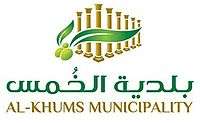Al Khums
| Al-Khums الخمس Khoms, Homs[1] | ||
|---|---|---|
|
"17 February Martyrs Monument" in Khums center | ||
| ||
 Al-Khums Location in Libya | ||
| Coordinates: 32°38′59″N 14°15′52″E / 32.64972°N 14.26444°ECoordinates: 32°38′59″N 14°15′52″E / 32.64972°N 14.26444°E | ||
| Country |
| |
| Region | Tripolitania | |
| District | Murqub | |
| Settled by Berbers and Phoenicians | around 1000 BC (as Lpqy) | |
| Government | ||
| • Governing body | Al-Khums Municipal Council | |
| • President of the Municipal Council | Bashir Alhnash | |
| Elevation[2] | 7 ft (2 m) | |
| Population (2004)[2] | ||
| • Total | 201,943 | |
| Demonym(s) | Khumsi | |
| Time zone | EET (UTC+2) | |
| Area code(s) | 31 | |
| Website | http://khoms.gov.ly/ | |
Al Khums or Khoms (Arabic: الخمس ) is a city, port and the de jure capital of the contested Murqub District on the Mediterranean coast of Libya[3] with an estimated population of around 202,000.[2] The population at the 1984 census was 38,174.[4] Between 1983 and 1995 it was the administrative center of the Al Khums District.
Etymology
The name Al Khums, Khoms or sometimes Homs (Arabic: الخُمس )[1] translated literally to "the quintile" in Arabic.[5] The origins of the name is not clear, though there are many theories explaining it. The most renowned are:
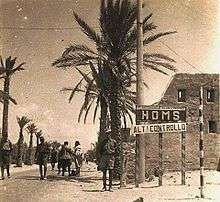
- In Tripolitania the quinary numeral system was used in contrary to most other Arabs who were using the decimal system and since Khums and neighbor villages were famous in producing olives and olive oil, they used a lot of counting and so other cities started to call them 'Khumsi' (Quinary) from which the name Khums derived[5]
- Some say the name Khums is an Arabic translation to the Greek word Pentapolis which means five cities, but this theory is believed to be false because Pentapolis and its cities are in Cyrenaica.[5]
- Another theory says that the city during 16th century was producing a quintile (20%) of the Ottoman Tripolitania province's olive oil.[5]
During the Italian occupation of Libya, the city was called Homs in the official Italian sources.
History
Leptis Magna
The city appears to have been founded by a group of local Berbers (and probably Phoenicians) sometime around 1000 BC, who gave it the Lybico-Berber name Lpqy.[6][7]
The town did not achieve prominence until Carthage became a major super power in the Mediterranean Sea in the 4th century BC. It nominally remained part of Carthage's dominions until the end of the Third Punic War in 146 BC and then became part of the Roman Republic, although from about 111 BC onward, it was for all intents and purposes an independent city.
Soon Italian merchants settled in the city and started a profitable commerce with the Libyan interior.[8] The republican Rome sent some colonists together with a small garrison in order to control the city. Since then the city started to grow and was even allowed to create its own money (coins).

Leptis Magna remained as such until the reign of the Roman emperor Tiberius, when the city and the surrounding area were formally incorporated into the empire as part of the province of Africa. It soon became one of the leading cities of Roman Africa and a major trading post.
Leptis achieved its greatest prominence beginning in 193 AD, when a Berber native son, Lucius Septimius Severus, became emperor. He favored his hometown above all other provincial cities, and the buildings and wealth he lavished on it made Leptis Magna the third-most important city in Africa, rivaling Carthage and Alexandria. In 205 AD, he and the imperial family visited the city and received great honors.

Among the changes that Severus introduced were to create a magnificent new forum and to rebuild the docks. The natural harbour had a tendency to silt up, but the Severan changes made this worse, and the eastern wharves are extremely well preserved, since they were scarcely used.
Leptis over-extended itself at this period. During the Crisis of the 3rd Century, when trade declined precipitously, Leptis Magna's importance also fell into a decline, and by the middle of the 4th century,even before it was completely devastated by the 365 tsunami, large parts of the city had been abandoned. Ammianus Marcellinus recounts that the crisis was worsened by a corrupt Roman governor named Romanus during a major tribal raid who demanded bribes to protect the city. The ruined city could not pay these and complained to the emperor Valentinian. Romanus then bribed people at court and arranged for the Leptan envoys to be punished "for bringing false accusations". It enjoyed a minor renaissance beginning in the reign of the emperor Theodosius I.
In 439 AD, Leptis Magna and the rest of the cities of Tripolitania fell under the control of the Vandals when their king, Gaiseric, captured Carthage from the Romans and made it his capital. Unfortunately for the future of Leptis Magna, Gaiseric ordered the city's walls demolished so as to dissuade its people from rebelling against Vandal rule. The people of Leptis and the Vandals both paid a heavy price for this in 523 AD when a group of Berber raiders sacked the city.
Belisarius recaptured Leptis Magna in the name of Rome ten years later, and in 534 AD, he destroyed the kingdom of the Vandals. Leptis became a provincial capital of the Eastern Roman Empire (see Byzantine Empire) but never recovered from the destruction wreaked upon it by the Berbers. It was the site of a massacre of Berber chiefs of the Leuathae tribal confederation by the Roman authorities in 543 AD.[9] Historian Theodore Mommsen wrote that under Byzantine rule the city was fully Christian.[10] During the decade 565-578 AD Christian missionaries from Leptis Magna even began to move once more among the Amazigh tribes as far south as the Fezzan in the Libyan desert and converted the Garamantes.[11] But the city's decadence - linked even to the Sahara's desertification - continued, even though new churches were built,[12] and by the time of the Arab conquest of Tripolitania in the 650s, the city was nearly abandoned except for a Byzantine garrison force.
The progressive growth of arid land around Leptis damaged its importance and the port become full of sand. As a consequence, when Arabs arrived around 640 AD and later conquered Leptis, they found only a little garrison and a small city of less than 1,000 inhabitants. Under Arab domination Leptis disappeared: by the 10th century the city was forgotten and fully covered by sand.[13]
Islamic rule
Leptis Magna and Tripolitania were conquered by Amr ibn al-Aas and soon after that, a lot of Arabs settled in the city near the ruins of Leptis Magna while most of the native Berber tribes living there converted to Islam.[14]
For the next few centuries the control of the city shifted between Rashidun Caliphate, Umayyad Caliphate, Abbasid Caliphate, Fatimid Caliphate, Zirids, Kingdom of Africa, Almohad Caliphate and Hafsids before felling under the control of Ottomans in the 1550s.
The city remained part of Ottoman Tripolitania until the World War I and the defeat and dissolution of the Ottoman Empire.
Italian Libya
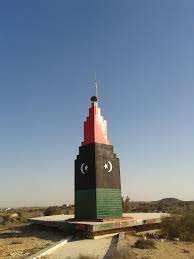
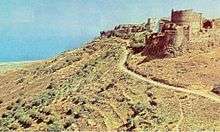
The Italians colonized Libya in 1911, and on 10 October of the same year a major battle between natives and Italian Army occurred in Murqub Castle in Khums and another on in the same place on 27 February 1912. Both battles named Battle of Murqub and are considered as two of the most important and renowned battles during the Italian colonizing of Libya. Muammer Gaddafi later claimed that his grandfather died in this battle.[15] Libya remained under Italian rule until World War II.
During World War II Khums was occupied by the Allies and from 1942 until 1951, when Libya gained independence, Tripolitania and the region of Cyrenaica were administered by the British Military Administration. Italy formally renounced its claim upon the territory in 1947.
Libyan Independence and Gaddafi regime
Bashir Saadawi who is born in Khums was one of the major figures who contributed to independence of Libya. He was the founder of the National Congress Party which supported a Republic system instead of a Monarchy. But when King Idris I was crowned as Libya King, all parties were disbanded and Saadawi exiled to Beirut where he lived the rest of his years and died on 17 January 1957.
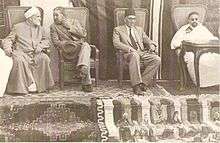
Khums remained part of Tripolitania province until 1962 when the Federal system canceled and replaced by Muhafazah governorates system (muhafazah) system, and this system remained even after the 1969 coup d'état and through the Libyan Arab Republic, until superseded by the 1983 Baladiyat districts system. The baladiyat system were also dropped in 1995 and replaced by thirteen districts named shabiyat. Desbite all those changes, Khums remained as a separate district under the name of Al Khums or Murqub.
Libyan Civil War
Khums remained under control of Gaddafi forces through most of the war until rebels from Misrata entered and captured the city on 23 August before moving on to Tripoli.[16]
Climate
| Climate data for Al Khums, Libya (1996–2008) | |||||||||||||
|---|---|---|---|---|---|---|---|---|---|---|---|---|---|
| Month | Jan | Feb | Mar | Apr | May | Jun | Jul | Aug | Sep | Oct | Nov | Dec | Year |
| Average high °C (°F) | 17.9 (64.2) |
18.7 (65.7) |
21.4 (70.5) |
24.0 (75.2) |
27.1 (80.8) |
29.6 (85.3) |
31.7 (89.1) |
32.0 (89.6) |
30.9 (87.6) |
29.0 (84.2) |
24.2 (75.6) |
19.4 (66.9) |
25.5 (77.9) |
| Daily mean °C (°F) | 13.5 (56.3) |
14.0 (57.2) |
16.6 (61.9) |
18.8 (65.8) |
22.4 (72.3) |
24.6 (76.3) |
26.9 (80.4) |
27.5 (81.5) |
26.5 (79.7) |
23.9 (75) |
19.2 (66.6) |
15.0 (59) |
20.7 (69.3) |
| Average low °C (°F) | 9.3 (48.7) |
9.4 (48.9) |
11.5 (52.7) |
13.6 (56.5) |
16.9 (62.4) |
19.3 (66.7) |
22.3 (72.1) |
22.9 (73.2) |
21.9 (71.4) |
19.3 (66.7) |
14.6 (58.3) |
10.2 (50.4) |
15.9 (60.6) |
| Average precipitation days (≥ 0.1 mm) | 6.0 | 4.0 | 2.8 | 1.0 | 0.4 | 0.6 | 0.0 | 0.4 | 1.6 | 3.1 | 4.8 | 6.4 | 30.9 |
| Mean monthly sunshine hours | 179.8 | 200.6 | 257.3 | 240.0 | 310.0 | 330.0 | 378.2 | 337.9 | 276.0 | 238.7 | 219.0 | 179.8 | 3,147.3 |
| Mean daily sunshine hours | 5.8 | 7.1 | 8.3 | 8.0 | 10.0 | 11.0 | 12.2 | 10.9 | 9.2 | 7.7 | 7.3 | 5.8 | 8.6 |
| Source: Deutscher Wetterdienst[17] | |||||||||||||
Al Khums municipality
Al Khums Municipality was once part of Murqub District and it's capital, since 2013 the 22 Shabiya divided into 90 Municipalities; and so Al Khums was separated from Zliten.[18]
Today Al Khums Municipality consists of some small towns on the outskirts of Al Khums Center like: Lebda, Seleen, El-Sahel and Suuq El-Khamis.
Sport
The city main football club is Al Khums SC which plays in Libyan Second Division.
Notable people

- Emperor Septimius Severus: The 21st Emperor of the Roman Empire who born in Leptis Magna. He was the founder of the Severan dynasty, the last dynasty of the empire before the Crisis of the Third Century.
- Bashir Saadawi: A major figure in Libya independence.
- Idi Amin: Lived in a hotel in the city a year between 1979 and 1980 after his exile from Uganda in the end of the Uganda–Tanzania War.
- Salem Al Rewani: A former Libyan international player and Al-Ittihad legend.
Transport
Khums has a plant for making Concrete sleepers, one of two in Libya.
See also
- List of cities in Libya
- Railway stations in Libya - proposed
References
- 1 2 Fisher, Morris (1985) Provinces and provincial capitals of the world (2nd edition) Scarecrow Press, Metuchen, New Jersey, page 88, ISBN 0-8108-1758-6
- 1 2 3 "Wolfram-Alpha: Computational Knowledge Engine".
- ↑ Staff (1972) "Al Khums" Merriam-Webster's Geographical Dictionary (3rd ed.) Merriam, Springfield, Mass., p. 33, OCLC 11616186
- ↑ "Al-Khums - Libya".
- 1 2 3 4 "الخمس". 18 September 2014.
- ↑ "Archaeological Site of Leptis Magna". World Heritage List. UNESCO. Retrieved March 14, 2013.
- ↑ Birley, Anthony Richard (1971) Septimius Severus Eyre and Spottiswoode, London, page 2, ISBN 0-413-26900-0
- ↑ Bullo, Silvia (1 January 2002). "Provincia Africa: le città e il territorio dalla caduta di Cartagine a Nerone". L'ERMA di BRETSCHNEIDER – via Google Books.
- ↑
 Herbermann, Charles, ed. (1913). "Leptis Magna". Catholic Encyclopedia. New York: Robert Appleton Company.
Herbermann, Charles, ed. (1913). "Leptis Magna". Catholic Encyclopedia. New York: Robert Appleton Company. - ↑ Theodore Mommsen. "The Provinces of the Roman Empire". section:Africa
- ↑ Prevost, Virginie (1 December 2007). "Les dernières communautés chrétiennes autochtones d'Afrique du Nord" (4): 461–483. doi:10.4000/rhr.5401 – via rhr.revues.org.
- ↑ Lendering, Jona. "Byzantine Church".
- ↑ Silvia Bullo. "Provincia Africa: Leptis Magna". pg 185-188
- ↑ History of Arabic Conquest in Libya by Al Zawwy (تاريخ الفتح العربي في ليبيا للزاوي)
- ↑ History of Libyan Jihad Book (كتاب تاريخ الجهاد الليبي)
- ↑ "Eastern rebels press onwards to Tripoli". Al Jazeera English. Retrieved 14 March 2012.
- ↑ "Klimatafel von El Khoms (al-Chums, Homs); Tripolitanien / Libyen" (PDF). Baseline climate means (1961-1990) from stations all over the world (in German). Deutscher Wetterdienst. Retrieved 27 March 2016.
- ↑ "Decisions and Laws 12 July 2013 (arabic)".

